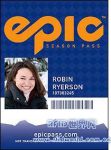
Vail Resort ski resort uses UHF RFID technology on season tickets
[ad_1]
Last winter, Vail Resort conducted a proof-of-concept test of an RFID application, using RFID technology at Vail Mountain to read and authenticate about 1,000 season passes held by ski patrollers and ski school employees. After testing and validation, the company has decided to attempt to issue RFID season cards to regular customers and employees at five ski resorts: Vail Mountain and three other ski resorts in Colorado: Breckenridge, Keystone and Beaver Creek, and at the California-Nevada border Heavenly Ski Resort.
The use of RFID technology in ski resorts is not a new application. It is already an application practice in Europe, and more and more American ski resorts have also begun to adopt RFID. But the difference is that instead of using high-frequency passive RFID tags commonly used in ski resorts, Vail uses newer, ultra-high-frequency passive EPC Gen 2 tags. The tags operate at 900 MHz and can read longer distances.

In 2007, the company hired RFID hardware and systems developer SkyeTek to study how to integrate RFID into the ski resort’s existing operational processes to improve customer experience and business efficiency, and conducted proof-of-concept tests. However, after testing was completed last year, Vail chose to design the RFID project independently, said Robert Urwiler, CIO of Vail Resorts.
Starting next winter, Robert Urwiler says all of Vail’s lifts will use handheld readers – Intermec’s CN3 mobile computer (consisting of an IP30 handheld EPC Gen 2 RFID reader and an integrated barcode scanner) – to collect skiers and skateboarders Season card and ID number.
The handheld device sends the ID number to the back-end software through the Wi-Fi network link, and the software will start to check whether the ID number is valid. If so, the software sends the cardholder’s digital photo, personal data (such as name and date of birth) to the handset. Next, the employee compares the photo with the actual cardholder.
If staff have questions about how well the photo matches the actual cardholder, they can raise a question to verify, such as the customer’s birthday. While this way of confirming season passes doesn’t save much time over traditional manual checks, it’s more convenient for customers because they don’t have to search for a season pass and show it to staff.
The main reason Vail uses UHF technology is the long-range reading of EPC Gen 2 UHF tags (UHF tags are read from tens of feet, while HF tags are read from only a few inches). While the HF tag read range is sufficient for handheld devices, Vail considers that other applications will require longer read ranges in the future. “UHF is more flexible than HF,” Urwiler said. “It gives us better visibility.”
In last season’s tests, Vail evaluated the Intermec handheld reader and the IF61 fixed reader, which has a longer read range. Reader antennas are installed on top of various lift rides, and when cardholders board the lift, the antenna reads the tag’s ID. “The lifts in the higher areas of Vail Mountain have historically not read customers’ cards, which means the ski resort doesn’t know where the skier was last, and this information is particularly useful for safety management,” Urwiler said.
Knowing where skiers are at altitude provides invaluable information for marketing and ski area planners. Not only can companies track individuals, but they can also observe and profit from group activity. For example, know the average age, gender and number of skiers and skateboarders arriving in a particular area, the total number of people using these lifts on a given day, etc.
For now, these anticipated benefits are not enough for the company to continue installing fixed readers on lifts high up on Vail Mountain. But the company does plan to continue collecting tag data from installed stationary readers and to use stationary readers on some pedestal lifts to assess their accuracy. “We already know the handsets work well, and we’ll use the tag data collected by the handsets to confirm that the top-mounted readers are not missing a read.”
Each season card contains an RFID inlay made by KSW Microtec using a G2XM RFID chip from NXP Semiconductors, an antenna designed by Zebra Technologies. Vail uses Zebra RFID printer-encoders to program and print the labels.
[ad_2]



